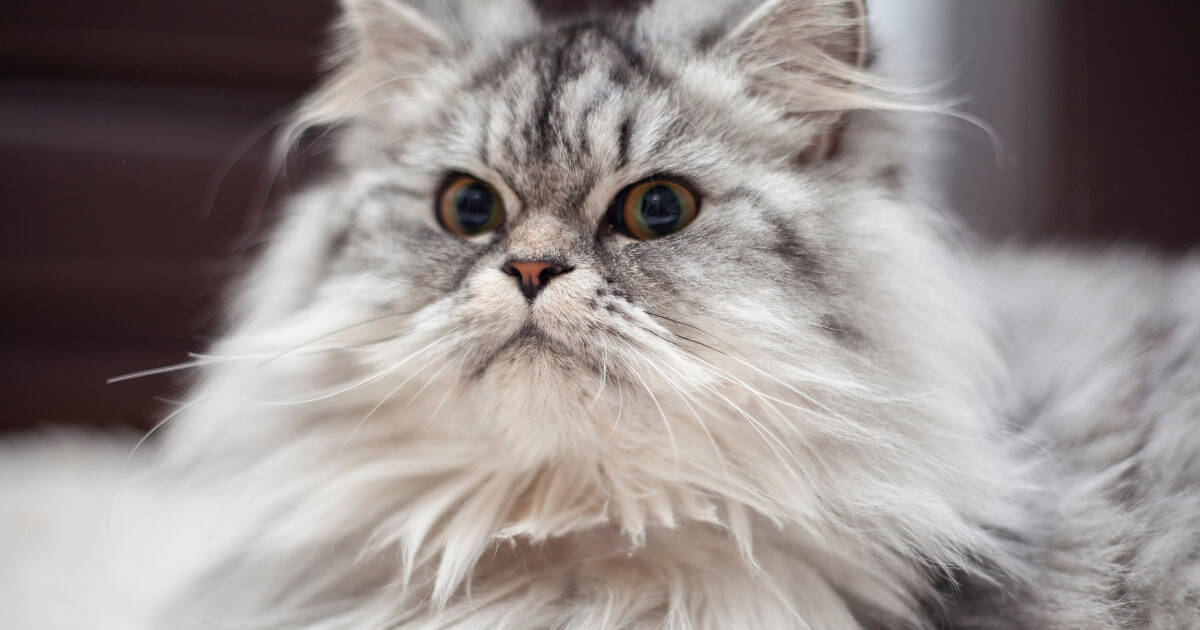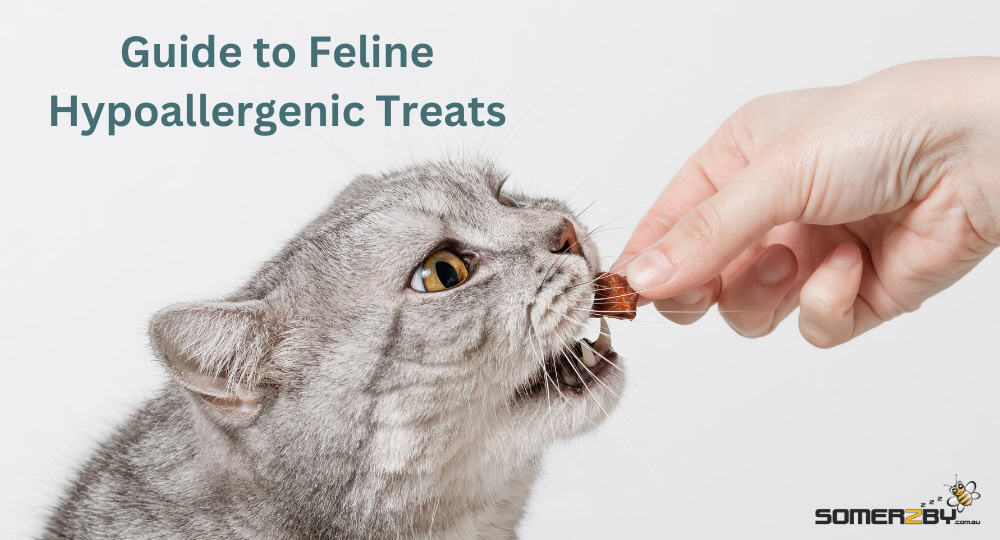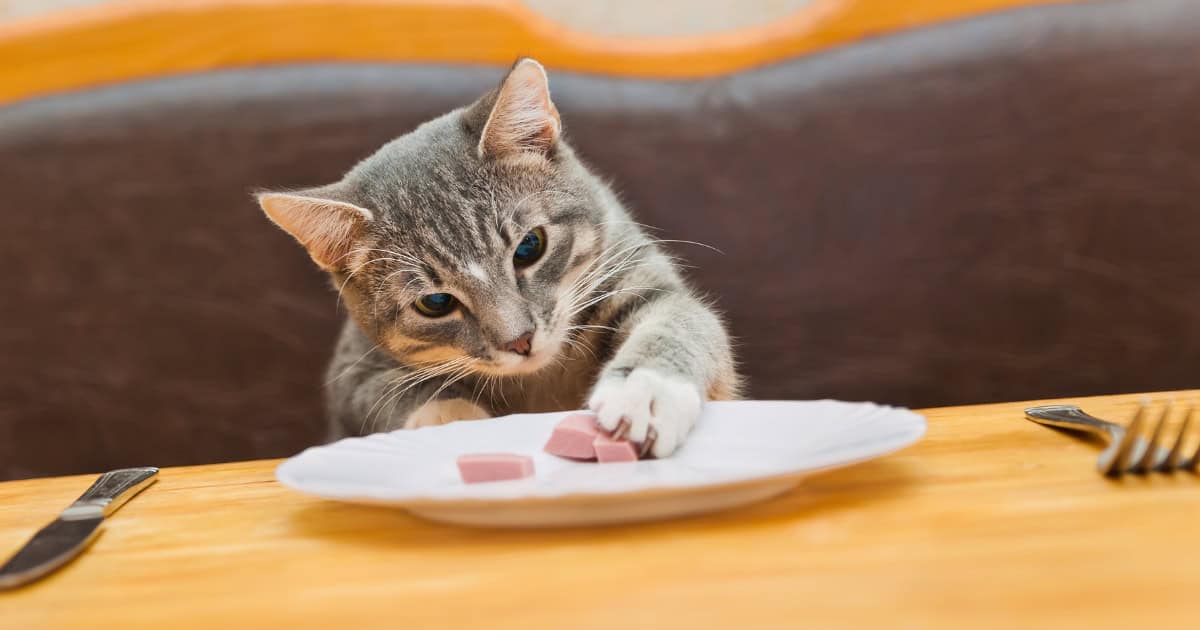Cats, Info Guides
Guide to Feline Hypoallergenic Treats
Hey there, pet lovers! Is your cat experiencing allergies? Dive into our latest blog that unveils the secrets of feline hypoallergenic treats.
From understanding allergic reactions to choosing the purr-fect nibbles, we’ve got the ultimate guide to helping your fur babies. Plus, discover the importance of patience when transitioning to new foods.
Ready to enhance your cat’s well-being? Read on and explore a world of feline hypoallergenic treats with Somerzby!
Understanding Hypoallergenic Treats for Cats
Hypoallergenic cat treats are designed for sensitive cats. They avoid ingredients known to cause allergies in felines and instead focus on those less likely to trigger adverse reactions.
What Are Allergic Reactions?
Allergic reactions occur when the immune system identifies certain substances as harmful, even though they aren’t usually so. In response, the body fights off these ‘invaders’, leading to uncomfortable symptoms.
Allergy Symptoms
The most common allergy symptoms cats experience include:
- Sensitive stomachs and vomiting
- Diarrhea or sudden changes in bowel movements
- Skin conditions including itchy skin
- Poor coat condition
Benefits of Hypoallergenic Cat Treats
If you suspect your cat might have a food allergy, consult with a vet who can help identify the cause. They may recommend a veterinary diet (aka. prescription diet) and suggest some treat alternatives.
Hypoallergenic treats are one such alternative – these are designed specifically for cats with sensitivities, avoid common allergens, and are highly digestible.
By reducing exposure to potential allergens found in regular cat snacks, we make sure our feline friends feel their best every day – no itchiness or discomfort here.
Besides health benefits though there’s another bonus: taste. Despite being free from many common ingredients these special nibbles often boast natural flavours that kitties love thanks partly due to fewer additives being used.
It’s like choosing a home-cooked meal over fast food – both can be tasty, but the former is usually better for you.
Achieve the perfect mix of flavour and dental health for your cat by incorporating hypoallergenic dental treats into their routine.

Common Allergens in Cat Treats
Cats, like humans, can be sensitive to certain foods and ingredients. Cat owners must be aware of common food allergens so they can dodge them when selecting snacks for their cats.
Dairy Products
Adult cats often lack the enzyme lactase, necessary for breaking down lactose in dairy products. This intolerance can lead to digestive problems such as diarrhea and stomach upset.
Fish
Surprisingly, fish is a common cause of allergies in cats. While some salmon cat food might be alright because it’s cooked at high temperatures which break down most allergens, undercooked fish and fish oil should be avoided.
Grains
Corn and wheat often pop up on the list of frequent offenders when talking about food allergies in cats. These grains are commonly used as fillers in pet foods and treats – making them prevalent sources of potential allergic reactions. Look for grain-free alternatives whenever possible.
Meat
Animal protein sources such as chicken, beef or lamb can cause allergic reactions. Packed chicken cat food is one of the most common triggers for symptoms.
How to Choose Feline Hypoallergenic Treats
If your cat is sensitive to certain food ingredients, you’ll need feline hypoallergenic treats. But how can you determine the correct hypoallergenic treats for your cat?
Understand Your Cat’s Specific Needs
Gain an understanding of what causes reactions in your cat. Some cats may be allergic to grains while others can’t tolerate certain proteins like chicken or beef. It might take some detective work, but observing their reaction after eating different foods will give valuable clues.
Veterinary advice should also be sought when dealing with food allergies. They can help confirm if it’s an allergy causing the issues and guide towards suitable dietary changes.
Avoid Common Allergens
Allergic reactions in cats are commonly triggered by dairy products, fish, meat by-products, grains and artificial additives found in many commercial treats.
When buying cat treats, read labels carefully. Aim for a simple ingredient list where every item is recognisable – less really is more here. Steer clear from preservatives or any artificial colours and flavours as they could potentially cause a flare-up.
Pick Reputable Brands
The brand reputation matters too when choosing hypoallergenic cat treats because not all brands prioritise quality control. Look for companies that have stringent manufacturing processes ensuring minimal cross-contamination risk between different product lines.
Choose the Right Ingredients
Hypoallergenic doesn’t mean tasteless. Many hypoallergenic cat treats use delicious ingredients that are less likely to cause allergies. For instance, high quality meat such as duck or venison is often well-tolerated by cats with food sensitivities.
If you feed your cat more than the occasional treat, shop for healthy treats with high protein and low fat content. Treats high in omega-3 fatty acids can ease allergy symptoms such as itchy skin or a matte coat.
Transitioning Your Cat to Hypoallergenic Treats
If your cat’s been itching more than usual or has an upset tummy, it might be a sign that they’re sensitive to something in their treats. Switching them over to diet hypoallergenic cat treats could make all the difference. But you’ve got to do it right.
Mixing Old and New Treats
Avoid sudden changes! Cat experts caution against abruptly changing diets as it can cause stomach upset and liver issues.
A good trick for healthy digestion is mixing old and new treats together for a few days before completely switching over. You can start with 75% of the old one mixed with 25% of the hypoallergenic treat for about three days.
After this period, change up the ratio – half-half would work well now – again keeping this going for around three days or so before moving on. Gradually increase until you’re feeding only hypoallergenic goodies.
Keep an eye out for any changes in your kitty’s behaviour or well-being during the shift. If you observe any signs of lethargy, decreased appetite or digestive issues, contact your vet promptly.
The Importance of Patience
Cats are creatures of habit; they like what they know. So if yours isn’t too keen at first, don’t fret – patience is key here. Keep offering smaller pieces of the healthy treat alongside familiar wet or dry food.
Encourage your cat to try new food by making it a game. Hide the treats in their favourite slow feeder and encourage them to hunt them out.
Toni’s Wrap
Feline hypoallergenic treats are highly beneficial for cats experiencing allergy symptoms.
From recognising common allergens to choosing the right treats based on individual needs, it’s clear that a well-informed approach is crucial to helping a cat with allergies. Transitioning to hypoallergenic options demands patience and a gradual shift.
Here at Somerzby, we strive to help cat owners provide the best possible care for their feline friends. Click here to answer frequently asked questions about cat care, click here to view our healthy cat treats and click here to view our range of quality cat enclosures.





